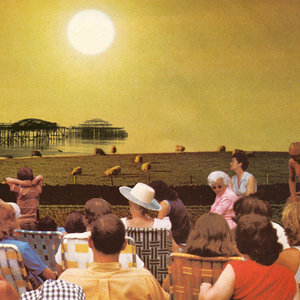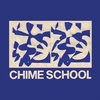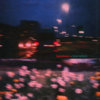Game Preserve by Bart Davenport

The last couple of years have seen a renaissance for West Coast singer-songwriters. LA-based youngsters such as Drugdealer and Sylvie have attracted considerable attention releasing warm and mellow records tonally reminiscent of the early 70s. Most fans of this new/old sound are unaware of Bart Davenport’s early explorations in the same sonic territory. His now 20-year-old “Game Preserve” album should gain an appreciative new audience with its first ever vinyl release.
In the year 2000, Bay Area troubadour Bart Davenport and several other musicians were recruited by a major tech corporation in Seattle to work on an algorithm-based music matching/search engine. It was what looked like the beginning of a promising career. After a year, however, the project was shelved. Bart and his colleagues were laid off with a healthy severance package... on the 12th of September, 2001. Not only had the musician’s life changed, so had the world. Rather than blow the money on a holiday or new car, Bart knew he had to make a record. A proper album that meant something.
Back in Oakland, he entered Wally Sound Studios with former Kinetics bandmate Jon Erickson at the controls, and a swathe of talented local musicians. “With Game Preserve,” Bart explains, “Jon and I really wanted to knock it out of the park. I wanted to utilize people from my old bands like Loved Ones drummer John Kent. I also invited my newer indie-pop friends from Call & Response, and a young Nedelle Torrisi. Harmony singing by The Moore Brothers was an essential ingredient on Game Preserve as well.”
Both Erickson and Davenport fondly recall growing up in households where the music of The Carpenters, Joni Mitchell and The Eagles soundtracked their young lives. By the early 00s they were ready to reconnect with what is often referred to as the “Laurel Canyon” sound. “I’d buy used tapes at garage sales and play them in the car. “Ladies Of The Canyon” by Joni and Jackson Browne’s first album were both in heavy rotation. Jon Erickson was getting deeper into the Steely-Mac-Doobie yacht-rock sound in earnest. A certain amount of childhood nostalgia led a lot of us back to that part of the 70s. I’d flirted with classic soft-rock on my first album, but that record was pretty scattered esthetically. I wanted my next one to be more focused. Jon and I made some ground rules: no electric guitars (except on ‘Bar-Code Trees’). No synths. Most importantly, all the songs have an air-tight, super dead, close mic’d drum sound. Putting these sorts of limitations on the sessions will give your record a specific quality. In the case of “Game Preserve” it’s mostly about tight drums, acoustic instruments and analog production. We used a 24-track, two-inch tape machine for tracking, then ran the mixes through an analog board straight to a 1/4 inch master tape.”
While the album’s sonic palette may be firmly planted in 1970, Davenport’s songwriting covers a sizable landscape of moods and reflections. From the quasi-flamenco intro of ‘Sweetest Game’ to the somber Wurlitzer of ‘Nowhere Left To Go’, to the 12-string shimmer of ‘Intertwine’, “Game Preserve” tells a story of young love, lost innocence and redemption, crossing borders and oceans along the way.
Released in 2003 on family-run Oakland label Antenna Farm, the ultra-analog sounding “Game Preserve” was only made available on digital formats, including CD. Copies were later pressed by labels in Germany and Spain; the latter being one country the album actually did well in, establishing Bart Davenport with a small but loyal fanbase he still enjoys today. Two European tours as support for Kings of Convenience also helped gain a foothold on the continent. Back in the US, however, Davenport and his sophomore album remained quite obscure.
Limited promotion meant it did little, but for the music lovers that heard it, the album undoubtedly remains a classic of the era, deserving far more. Twenty years on, it now finally receives its vinyl debut. “I personally think it holds up well,” says Bart of the album two decades later. “The idea was to make something that could be an homage to late ’60s/early ’70s West Coast pop but hopefully timeless as well. Years on, I hear it as just that. It was a colorful and brief period of my life that felt at times like it could last forever. I discovered the joy of working in a proper studio with a perfect cast of characters. I’m still very close with all these people and still play music with many of them.”
---------------------------------------------------
En los dos últimos años se ha producido un renacimiento de los cantautores de la Costa Oeste. Jóvenes de Los Ángeles como Drugdealer y Sylvie han llamado mucho la atención con discos cálidos y suaves que recuerdan tonalmente a los primeros años setenta. La mayoría de los aficionados a este nuevo/viejo sonido desconocen las primeras incursiones de Bart Davenport en el mismo territorio sonoro. Su álbum “Game Preserve”, que cumple ahora 20 años, debería ganarse un público nuevo con su primera edición en vinilo.
En el año 2000, Bart Davenport, trovador de la Bay Area, y varios músicos más fueron contratados por una importante empresa tecnológica de Seattle para trabajar en un motor de búsqueda musical basado en algoritmos. Parecía el comienzo de una carrera prometedora. Sin embargo, al cabo de un año, el proyecto se archivó. Bart y sus compañeros fueron despedidos con una buena indemnización... el 12 de septiembre de 2001. No sólo había cambiado la vida del músico, sino también el mundo. En lugar de gastar el dinero en unas vacaciones o un coche nuevo, Bart sabía que tenía que hacer un disco. Un álbum de verdad que significara algo.
De vuelta en Oakland, entró en los estudios Wally Sound con su antiguo compañero de banda Jon Erickson a los mandos y un grupo de músicos locales de gran talento. “Con Game Preserve”, explica Bart, “Jon y yo queríamos hacer algo grande. Quería contar con gente de mis antiguos grupos, como John Kent, batería de Loved Ones. También invité a mis nuevos amigos de Call & Response y a una joven Nedelle Torrisi. Las armonías vocales de The Moore Brothers también fueron un ingrediente esencial en Game Preserve”.
Tanto Erickson como Davenport recuerdan con cariño haber crecido en hogares donde la música de The Carpenters, Joni Mitchell y The Eagles era la banda sonora de sus jóvenes vidas. A principios de los dos mil, estaban preparados para reconectar con lo que a menudo se conoce como el sonido “Laurel Canyon”. “Compraba cintas usadas en mercadillos y las ponía en el coche. “Ladies Of The Canyon”, de Joni, y el primer álbum de Jackson Browne estaban muy presentes. Jon Erickson se adentraba cada vez más en el sonido yacht-rock de Steely-Mac-Doobie. Una cierta nostalgia de la infancia nos llevó a muchos de nosotros a esa parte de los años setenta. Yo había coqueteado con el soft-rock clásico en mi primer álbum, pero ese disco era bastante disperso estéticamente. Quería que el siguiente estuviera más centrado. Jon y yo establecimos algunas reglas básicas: nada de guitarras eléctricas (excepto en ‘Bar-Code Trees’). Nada de sintetizadores. Y lo que es más importante, todas las canciones tienen un sonido de batería hermético y grabado con micrófonos muy cercanos. Poner este tipo de limitaciones en las sesiones le da a tu disco una calidad específica. En el caso de “Game Preserve”, se trata sobre todo de una batería compacta, instrumentos acústicos y producción analógica. Utilizamos una grabadora de cinta de dos pulgadas con 24 pistas y luego pasamos las mezclas por una mesa analógica directamente a una cinta maestra de un cuarto de pulgada”.
Aunque la paleta sonora del álbum esté firmemente anclada en 1970, la composición de Davenport abarca un amplio paisaje de estados de ánimo y reflexiones. Desde la introducción casi flamenca de ‘Sweetest Game’ hasta el sombrío Wurlitzer de ‘Nowhere Left To Go’, pasando por el brillo de las 12 cuerdas de ‘Intertwine’, “Game Preserve” cuenta una historia de amor juvenil, inocencia perdida y redención, cruzando fronteras y océanos por el camino.
Publicado en 2003 por el sello Antenna Farm, de Oakland, el sonido ultra analógico de “Game Preserve” sólo estuvo disponible en formatos digitales, incluido el CD. Más tarde, sellos de Alemania y España publicaron copias; este último fue uno de los países en los que el álbum funcionó bien, y Bart Davenport se hizo con una pequeña pero leal base de seguidores de la que sigue disfrutando hoy en día. Dos giras europeas como telonero de Kings of Convenience también le ayudaron a afianzarse en el continente. En Estados Unidos, sin embargo, Davenport y su segundo álbum permanecieron en la oscuridad.
La escasa promoción que se le dio no sirvió de mucho, pero para los amantes de la música que lo escucharon el álbum sigue siendo un clásico de la época, que merecía mucho más. Veinte años después, por fin debuta en vinilo. “Personalmente, creo que se mantiene bien”, dice Bart en la actualidad. “La idea era hacer algo que pudiera ser un homenaje al pop de la costa oeste de finales de los 60 y principios de los 70, pero que también fuera atemporal. Años después, lo considero precisamente eso. Fue un breve y colorido periodo de mi vida que a veces parecía como si fuera a durar para siempre. Descubrí el placer de trabajar en un estudio adecuado con un elenco perfecto de personas. Sigo muy unido a toda esa gente y sigo tocando música con muchos de ellos”.
Tracklist
| 1. | Sweetest Game | 3:13 |
| 2. | The Saviors | 2:35 |
| 3. | Bar-Code Trees | 4:55 |
| 4. | Euphoria or Everyone On Earth Is So Beautiful, Even You | 3:43 |
| 5. | Summer In Her Hair | 4:02 |
| 6. | Sideways Findways | 2:48 |
| 7. | When You’re Sad | 3:40 |
| 8. | Porcelain Frog | 0:50 |
| 9. | My Brother Woody | 2:34 |
| 10. | Nowhere Left To Go | 3:33 |
| 11. | Tee | 2:26 |
| 12. | Intertwine | 2:58 |
Credits
Produced by Jon Erickson
All songs written by Bart Davenport (Vic Silva Songs/BMI)
Except ‘My Brother Woody’ (Chris Dedrick/Almitra Inc/Record Songs Inc/ASCAP)
Recorded, Engineered & Mixed by Wally at The Wally Sound, Oakland CA, Autumn 2002
This album was tracked entirely on two-inch tape, then mixed down through an analog console to quarter-inch tape.
Remastered for vinyl by JJ Golden at Golden Mastering, Ventura CA, Autumn 2021
Mastered by Paul Stubblebine, San Francisco, CA
Artwork by Jeffrey Charles
Photo of Bart & Friends by Terri Loewenthal







